Abstract
Because somatostatin, a neuroregulatory peptide, is found in abundance in the atria and atrioventricular node, its electrophysiological and antiarrhythmic properties were compared with those of verapamil in ten patients with paroxysmal atrioventricular tachycardia. During sinus rhythm, intravenous somatostatin slowed the heart rate whereas verapamil increased it. Though both agents prolonged atrioventricular conduction time and refractoriness, verapamil was more potent. They were equally effective at terminating reentry atrioventricular tachycardia, restoring sinus rhythm in six of seven patients. Whereas verapamil consistently blocked conduction in the atrioventricular node, somatostatin usually induced ventricular extrasystoles at the time of conversion. Somatostatin may have physiological importance in the neurohumoral control of cardiac impulse formation and conduction.
Full text
PDF
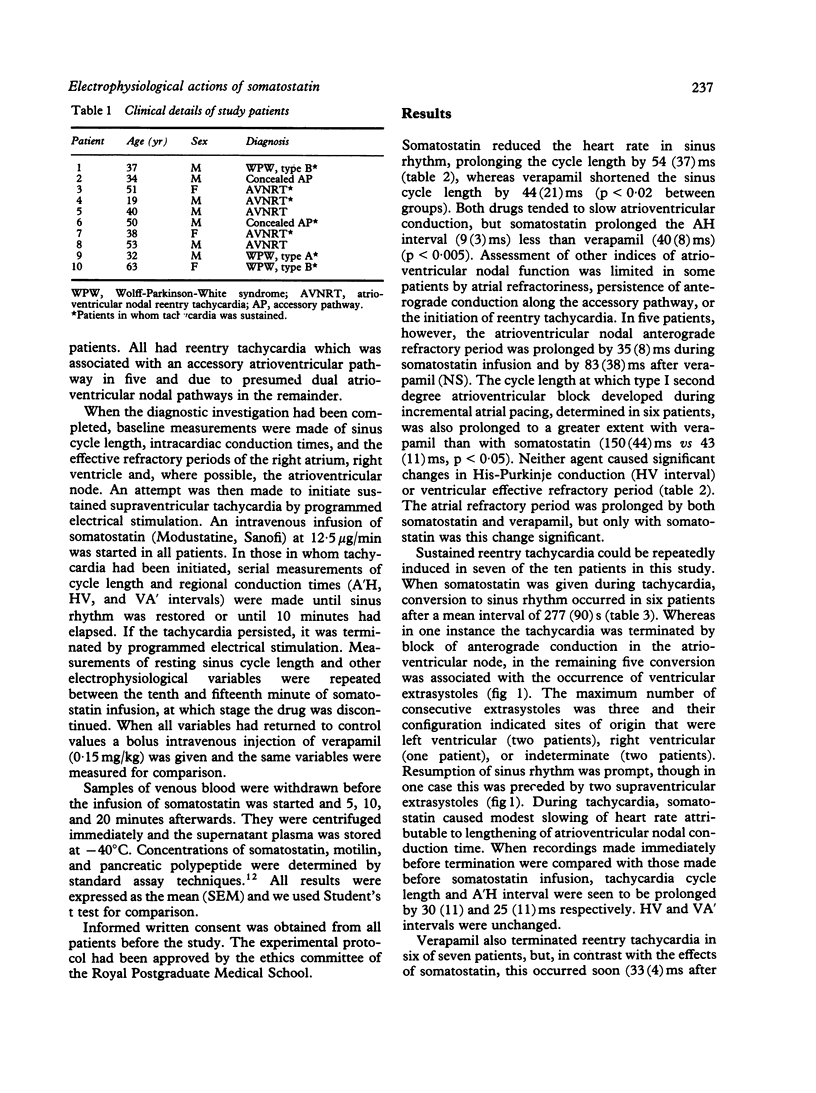
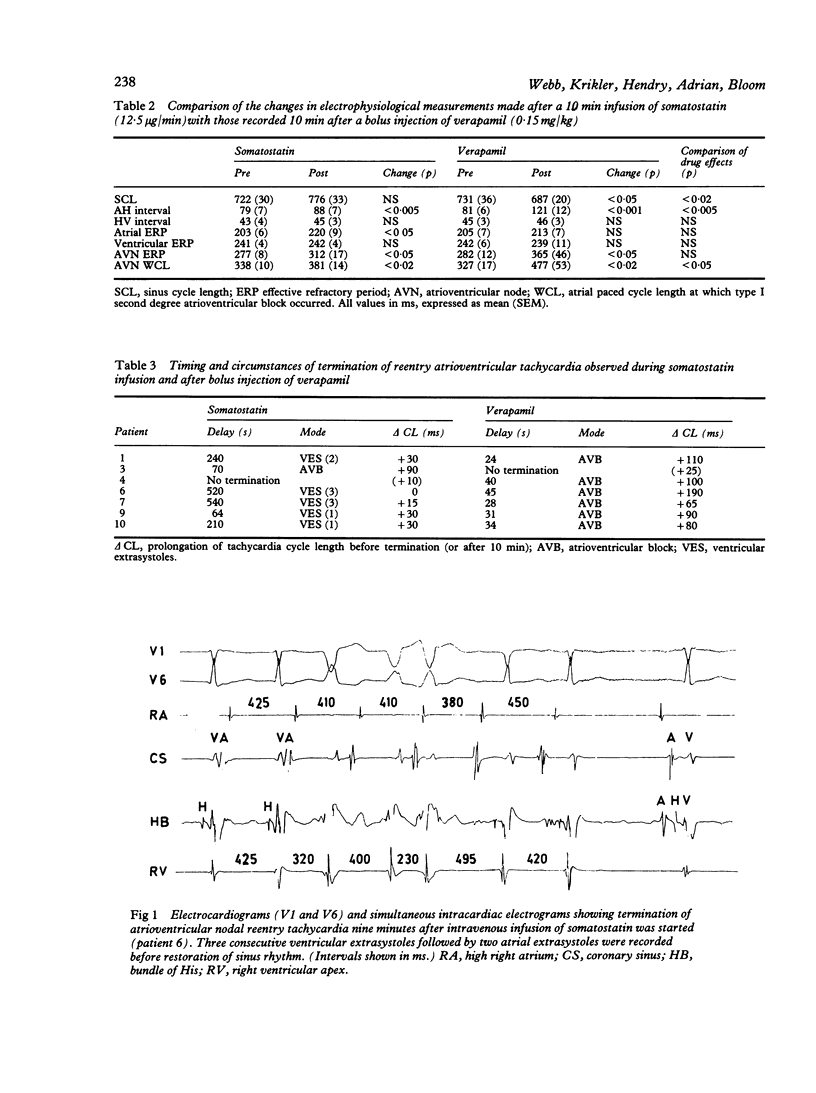
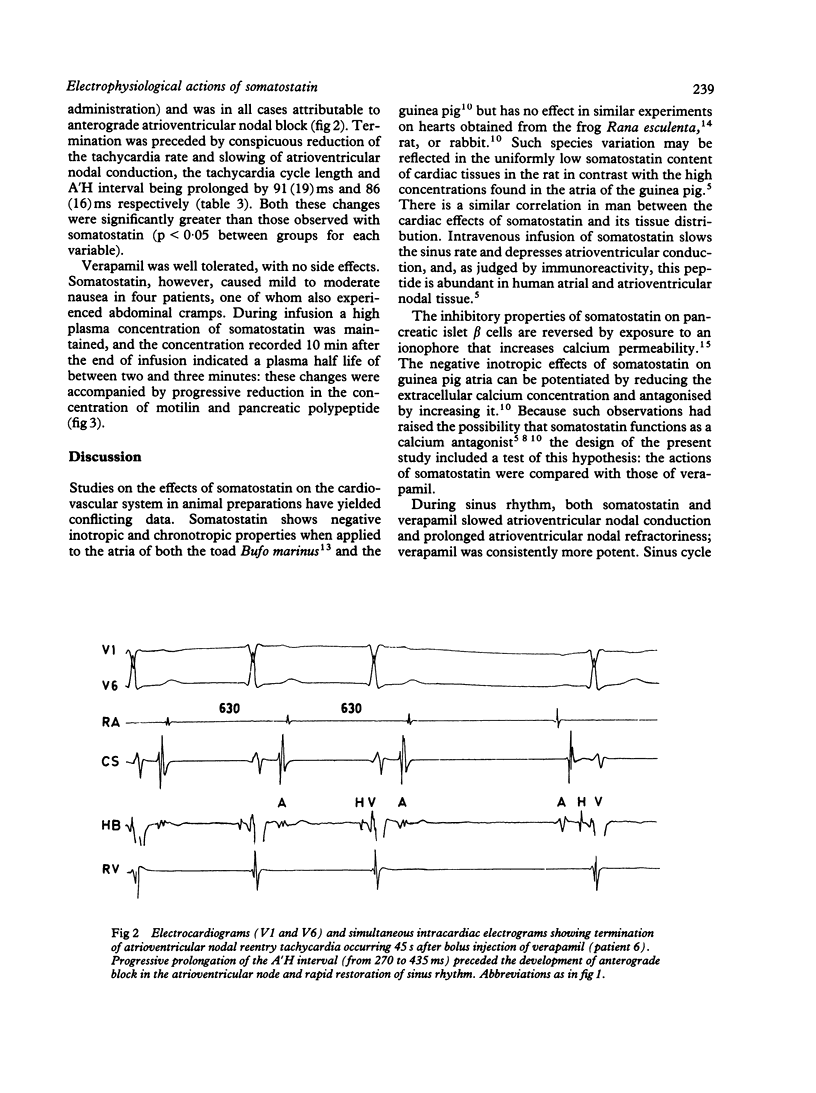
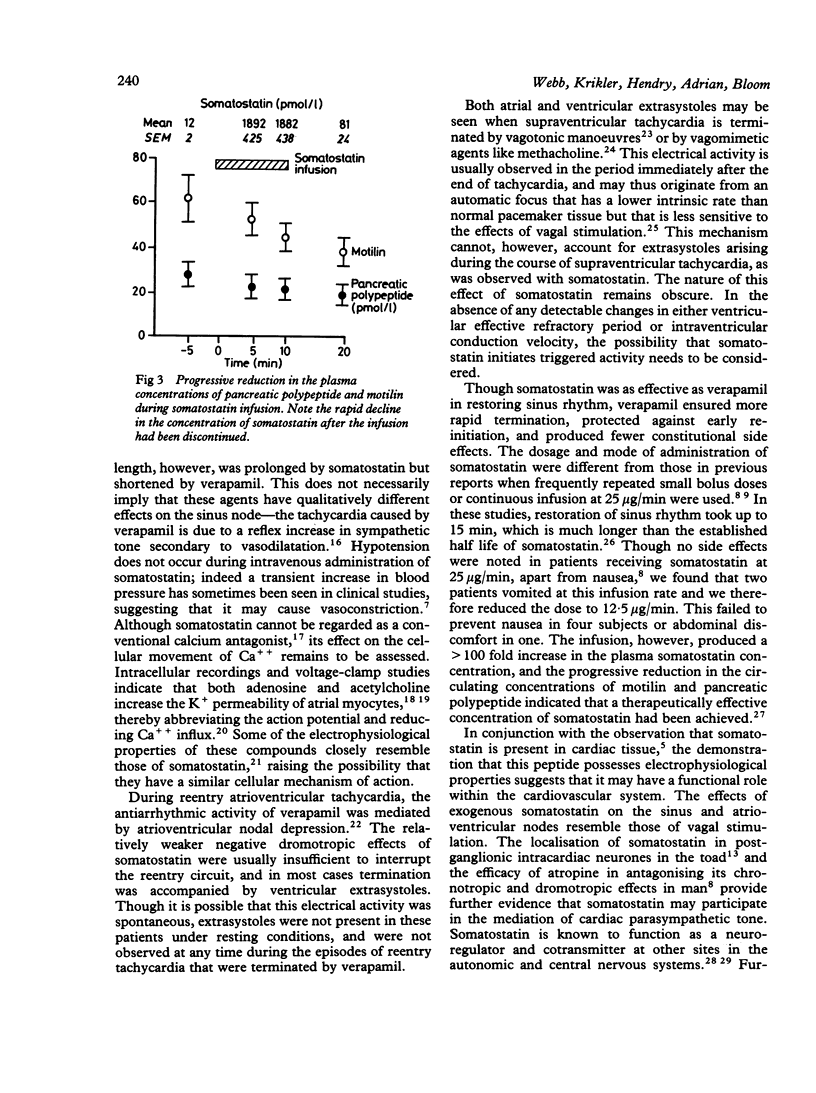
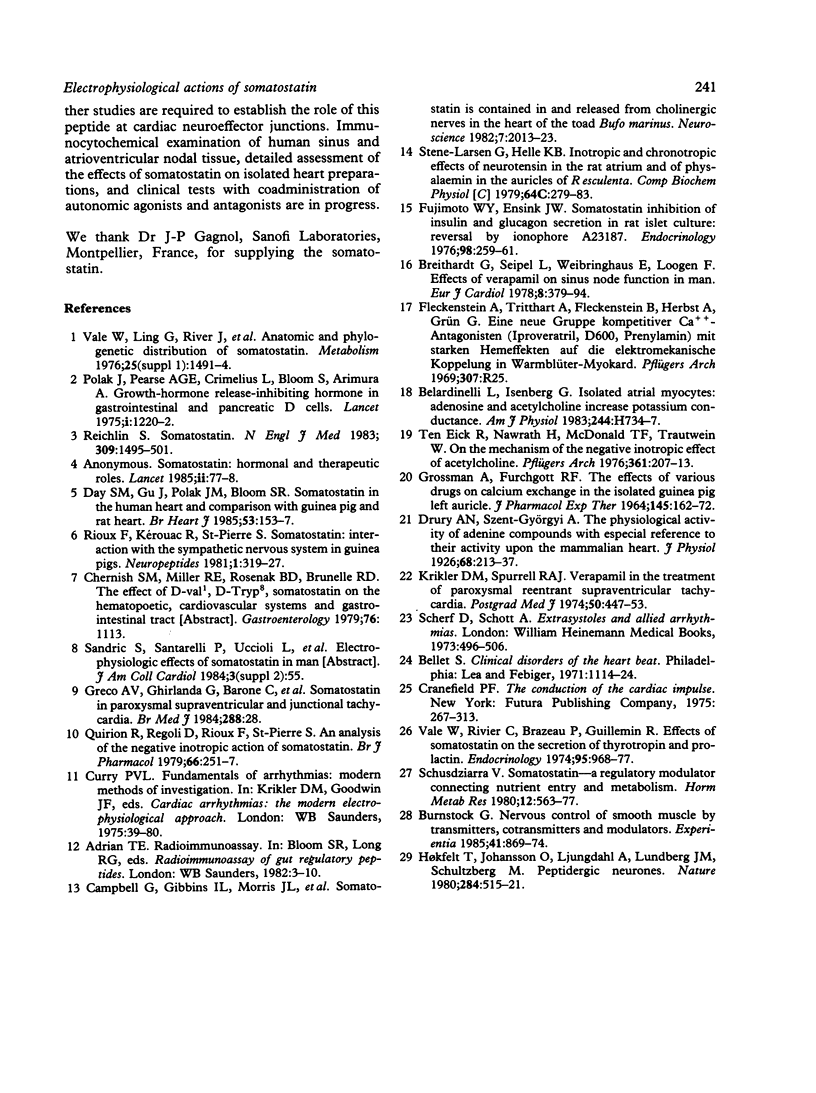
Selected References
These references are in PubMed. This may not be the complete list of references from this article.
- Belardinelli L., Isenberg G. Isolated atrial myocytes: adenosine and acetylcholine increase potassium conductance. Am J Physiol. 1983 May;244(5):H734–H737. doi: 10.1152/ajpheart.1983.244.5.H734. [DOI] [PubMed] [Google Scholar]
- Breithardt G., Seipel L., Wiebringhaus E., Loogen F. Effects of verapamil on sinus node function in man. Eur J Cardiol. 1978 Oct;8(3):379–394. [PubMed] [Google Scholar]
- Brindis R. G., Brundage B. H., Ullyot D. J., McKay C. W., Lipton M. J., Turley K. Graft patency in patients with coronary artery bypass operation complicated by perioperative myocardial infarction. J Am Coll Cardiol. 1984 Jan;3(1):55–62. doi: 10.1016/s0735-1097(84)80430-1. [DOI] [PubMed] [Google Scholar]
- Burnstock G. Nervous control of smooth muscle by transmitters, cotransmitters and modulators. Experientia. 1985 Jul 15;41(7):869–874. doi: 10.1007/BF01970003. [DOI] [PubMed] [Google Scholar]
- Campbell G., Gibbins I. L., Morris J. L., Furness J. B., Costa M., Oliver J. R., Beardsley A. M., Murphy R. Somatostatin is contained in and released from cholinergic nerves in the heart of the toad Bufo marinus. Neuroscience. 1982;7(9):2013–2023. doi: 10.1016/0306-4522(82)90116-6. [DOI] [PubMed] [Google Scholar]
- Day S. M., Gu J., Polak J. M., Bloom S. R. Somatostatin in the human heart and comparison with guinea pig and rat heart. Br Heart J. 1985 Feb;53(2):153–157. doi: 10.1136/hrt.53.2.153. [DOI] [PMC free article] [PubMed] [Google Scholar]
- Drury A. N., Szent-Györgyi A. The physiological activity of adenine compounds with especial reference to their action upon the mammalian heart. J Physiol. 1929 Nov 25;68(3):213–237. doi: 10.1113/jphysiol.1929.sp002608. [DOI] [PMC free article] [PubMed] [Google Scholar]
- Fujimoto W. Y., Ensinck J. W. Somatostatin inhibition of insulin and glucagon secretion in rat islet culture: reversal by ionophore A23187. Endocrinology. 1976 Jan;98(1):259–262. doi: 10.1210/endo-98-1-259. [DOI] [PubMed] [Google Scholar]
- GROSSMAN A., FURCHGOTT R. F. THE EFFECTS OF VARIOUS DRUGS ON CALCIUM EXCHANGE IN THE ISOLATED GUINEA-PIG LEFT AURICLE. J Pharmacol Exp Ther. 1964 Aug;145:162–172. [PubMed] [Google Scholar]
- Greco A. V., Ghirlanda G., Barone C., Bertoli A., Caputo S., Uccioli L., Manna R. Somatostatin in paroxysmal supraventricular and junctional tachycardia. Br Med J (Clin Res Ed) 1984 Jan 7;288(6410):28–28. doi: 10.1136/bmj.288.6410.28. [DOI] [PMC free article] [PubMed] [Google Scholar]
- Hökfelt T., Johansson O., Ljungdahl A., Lundberg J. M., Schultzberg M. Peptidergic neurones. Nature. 1980 Apr 10;284(5756):515–521. doi: 10.1038/284515a0. [DOI] [PubMed] [Google Scholar]
- Krikler D. M., Spurrell R. A. Verapamil in the treatment of paroxysmal supraventricular tachycardia. Postgrad Med J. 1974 Jul;50(585):447–453. doi: 10.1136/pgmj.50.585.447. [DOI] [PMC free article] [PubMed] [Google Scholar]
- Polak J. M., Pearse A. G., Grimelius L., Bloom S. R. Growth-hormone release-inhibiting hormone in gastrointestinal and pancreatic D cells. Lancet. 1975 May 31;1(7918):1220–1222. doi: 10.1016/s0140-6736(75)92198-4. [DOI] [PubMed] [Google Scholar]
- Quirion R., Regoli D., Rioux F., St-Pierre S. An analysis of the negative inotropic action of somatostatin. Br J Pharmacol. 1979 Jun;66(2):251–257. doi: 10.1111/j.1476-5381.1979.tb13673.x. [DOI] [PMC free article] [PubMed] [Google Scholar]
- Reichlin S. Somatostatin. N Engl J Med. 1983 Dec 15;309(24):1495–1501. doi: 10.1056/NEJM198312153092406. [DOI] [PubMed] [Google Scholar]
- Schusdziarra V. Somatostatin--a regulatory modulator connecting nutrient entry and metabolism. Horm Metab Res. 1980 Nov;12(11):563–577. doi: 10.1055/s-2007-999203. [DOI] [PubMed] [Google Scholar]
- Stene-Larsen G., Helle K. B. Inotropic and chronotropic effects of neurotensin in the rat atrium and of physalaemin in the auricles of R. esculenta. Comp Biochem Physiol C. 1979;64C(2):279–283. doi: 10.1016/0306-4492(79)90064-9. [DOI] [PubMed] [Google Scholar]
- Ten Eick R., Nawrath H., McDonald T. F., Trautwein W. On the mechanism of the negative inotropic effect of acetylcholine. Pflugers Arch. 1976 Feb 24;361(3):207–213. doi: 10.1007/BF00587284. [DOI] [PubMed] [Google Scholar]
- Vale W., Ling N., Rivier J., Villarreal J., Rivier C., Douglas C., Brown M. Anatomic and phylogenetic distribution of somatostatin. Metabolism. 1976 Nov;25(11 Suppl 1):1491–1494. doi: 10.1016/s0026-0495(76)80175-8. [DOI] [PubMed] [Google Scholar]
- Vale W., Rivier C., Brazeau P., Guillemin R. Effects of somatostatin on the secretion of thyrotropin and prolactin. Endocrinology. 1974 Oct;95(4):968–977. doi: 10.1210/endo-95-4-968. [DOI] [PubMed] [Google Scholar]


